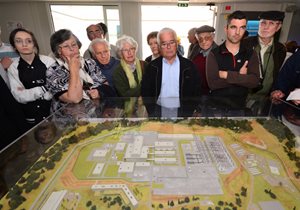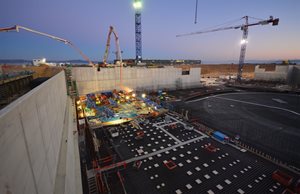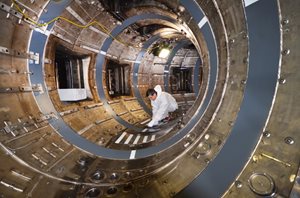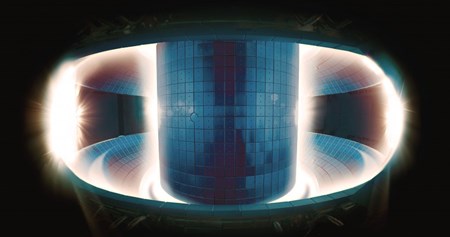
In the heart of the Korean tokamak KSTAR, in operation since 2008, a plasma pulse burns brightly. But don't be fooled—the brightest areas of the photo are in fact the coolest. At 150 million °C (the temperature in the centre), the plasma doesn't emit in the spectrum of visible light. © National Fusion Research Institute, Korea
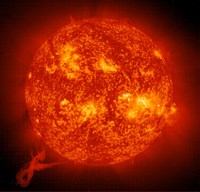
Six thousand degrees Celsius at the surface, 15 million at the centre. In the extreme density and temperature of the centre of the Sun, fusion reactions are possible. To create fusion in a tokamak plasma—an environment one million times less dense than the air we breathe—much higher temperatures must be attained. © SOHO-NASA-ESA
"Temperature" is not the same as "heat." Let's take the example of a fluorescent tube, which contains a gas such as neon, argon or mercury vapour that has been energized by an electrical discharge. Inside of the tube the temperature of the gas is elevated (on the order of 10,000 to 15,000 °C) but the tube can be touched without harm.How to obtain fusion reactions
To initiate fusion reactions, a small quantity of gaseous fuel composed of equal parts of hydrogen isotopes (deuterium and tritium) is injected into the vacuum vessel. By applying a powerful electrical current to this mixture the gas is transformed into a plasma—electrons are stripped from the nuclei and the tenuous mixture turns into a conducting environment.
An electrical current circulating through the plasma augments the temperature of the plasma progressively. On the same principle as a toaster or an electric radiator, "Ohmic (or resistance) heating" will bring the plasma to approximately 10 million °C.
To surpass this limit, other techniques are needed. Two auxiliary methods will be used on the ITER machine: radiofrequency microwaves (the ITER systems will be 25,000 times more powerful than an average microwave and are effective at different wavelengths); and the injection of high-energy particles that transfer their energy to the heart of the plasma.
Each of these auxiliary methods is capable on its own of bringing the ITER plasma to the required temperatures. As an experimental machine, ITER will test both to determine which is better adapted for future industrial fusion devices.
Now let's return to ITER and to its plasma temperatures of 150 to 300 million °C. Plasmas are very tenuous environments, nearly one million times less dense than the air we breathe. The plasma particles are heated—that is, sped up—by different types of auxiliary heating methods until they are possessed of a formidable amount of energy. When they collide, the shock is such that the electromagnetic barrier that surrounds them is overcome, and the fusion of atoms can take place.

